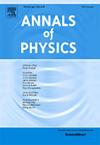The extreme Reissner–Nordström Black Hole: New exact solutions to the Klein–Gordon equation with minimal coupling
IF 3
3区 物理与天体物理
Q2 PHYSICS, MULTIDISCIPLINARY
引用次数: 0
Abstract
The omission of numerical methods to solve the Klein–Gordon equation with extremal black holes background is a well known problem. The difficulty forces the numerical investigation stop short at the near-extremal limit. In this work, we present a novel exact scalar quasibound states solutions in the extremal Reissner–Nordström black hole background. We start with the construction of the Klein–Gordon equation with minimal coupling in the extremal Reissner–Nordström black hole background and applying the separation of variables ansatz. We successfully find and present the exact solutions to the radial Klein–Gordon equation in the terms of the double confluent Heun functions. The exact eigenfrequencies expression of the scalar field bound to the extremal Reissner–Nordström black hole background, i.e., the quasibound states frequency, is subsequently determined by applying the polynomial condition to the double confluent Heun function. By utilizing the obtained exact quasibound states formula, we present an analytic proof to the nonexistence of charged scalar cloud in the extreme Reissner–Nordström black hole. And lastly, for the sake of completeness of the investigation, by utilizing the obtained exact radial wave function, we re-investigate the Hawking radiation and present a derivation to the extremal black hole horizon’s zero Hawking temperature via the Damour–Ruffini formulation.
极端Reissner-Nordström黑洞:最小耦合Klein-Gordon方程的新精确解
对于具有极值黑洞背景的Klein-Gordon方程,缺少数值方法求解是一个众所周知的问题。这一困难迫使数值研究在接近极值极限时停止。在这项工作中,我们提出了一种新的精确标量准束缚态解在极端Reissner-Nordström黑洞背景下。我们首先在极值Reissner-Nordström黑洞背景下构造具有最小耦合的Klein-Gordon方程,并应用分离变量ansatz。我们成功地找到并给出了双合流Heun函数形式的径向Klein-Gordon方程的精确解。通过对双合流Heun函数应用多项式条件,确定了与极值Reissner-Nordström黑洞背景相结合的标量场的精确特征频率表达式,即准边界态频率。利用得到的精确准束缚态公式,给出了极端Reissner-Nordström黑洞中带电标量云不存在的解析证明。最后,为了研究的完整性,利用得到的精确径向波函数,我们重新研究了霍金辐射,并通过Damour-Ruffini公式推导了黑洞视界极限零霍金温度。
本文章由计算机程序翻译,如有差异,请以英文原文为准。
求助全文
约1分钟内获得全文
求助全文
来源期刊

Annals of Physics
物理-物理:综合
CiteScore
5.30
自引率
3.30%
发文量
211
审稿时长
47 days
期刊介绍:
Annals of Physics presents original work in all areas of basic theoretic physics research. Ideas are developed and fully explored, and thorough treatment is given to first principles and ultimate applications. Annals of Physics emphasizes clarity and intelligibility in the articles it publishes, thus making them as accessible as possible. Readers familiar with recent developments in the field are provided with sufficient detail and background to follow the arguments and understand their significance.
The Editors of the journal cover all fields of theoretical physics. Articles published in the journal are typically longer than 20 pages.
 求助内容:
求助内容: 应助结果提醒方式:
应助结果提醒方式:


